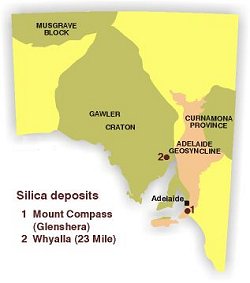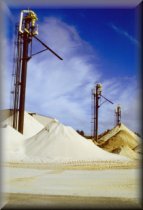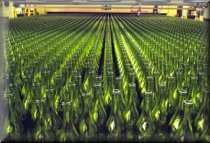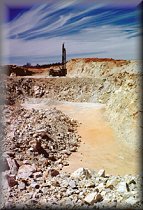 Silica (silicon dioxide, SiO2) occurs as the mineral quartz, a major constituent in many igneous and sedimentary rocks, and the most common detrital mineral in sandstone. As a commodity, the term silica is applied to quartz in all its forms — as vein or reef quartz, quartz pebbles, sandstone, quartzite, or as unconsolidated sand. World consumption approximates 120 Mt/year. Quartzite, sand and gravel used for construction purposes are excluded from this category.
Silica (silicon dioxide, SiO2) occurs as the mineral quartz, a major constituent in many igneous and sedimentary rocks, and the most common detrital mineral in sandstone. As a commodity, the term silica is applied to quartz in all its forms — as vein or reef quartz, quartz pebbles, sandstone, quartzite, or as unconsolidated sand. World consumption approximates 120 Mt/year. Quartzite, sand and gravel used for construction purposes are excluded from this category.
The main use of silica is for flat and container glass manufacture, with ~60% of each glass batch being silica sand. Silica sand is bonded with synthetic resins to make moulds and cores for casting metals in metal foundries. In oil drilling, well-rounded sand is used to prop open fissures in reservoir rocks to improve permeability. In the metallurgical industries, lump silica (quartzite) is used as a flux in metal smelting, and as a raw material for the manufacture of ferrosilicon. Silica is used in a variety of ceramics and specialty glasses, and is the raw material for manufacture of silicon compounds such as silicones, silanes, and high-purity silicon metal for semiconductors.
South Australian deposits
In South Australia, silica sand for foundry and glass making purposes is mined from Holocene dunes near Sandy Creek, Tailem Bend and Balaklava. The most significant silica mines are the Glenshera sand pit near Mount Compass, 50 km south of Adelaide, and the 23-Mile lump silica deposit near Whyalla.
2013 production of glass and foundry sand was 476,000 tonne, dominantly from the Glenshera mine area. Production of crushed quartz from the 23-Mile quarry was estimated at 26,000 tonne.
Glenshera
Unimin Australia Ltd now operate the former ACI silica sand pit at Glenshera to supply Australia’s largest container glass plant at Croydon, a western suburb of Adelaide. Production of silica sand commenced at Glenshera in 1987 and replaced ACI’s former beach dune sand mining operation at Normanville. The deposit contains Permian fluvioglacial sand, some of which was reworked during the Tertiary. Up to 10 m of yellow and orange sand, which is upgraded for amber glass and foundry sand, overlies pale cream sand which is processed for colourless container glass . The lower unit reaches 80 m in thickness, but mining depth is limited by the watertable. An on-site processing plant comprises trommels and vibrating screens to remove oversize, attritioning cells to remove surface coatings from the grains, and spirals to remove heavy minerals. The product is dewatered in hydrocyclones, and process water is recycled after passing through a Delta-stack clarifier. The 1999 production of 105 000 t of glass sand was used to manufacture container glass for the wine, brewing, food, and soft drink industries, and 38 000 t of foundry sand was produced for use by local foundries.
A PIRSA program of 64 RC drillholes totalling 2463 m, undertaken in 1998 to evaluate sand resources in the Mount Compass area, indicated that there is considerable potential to prove up additional deposits of glass sand (fig.1).
23-Mile deposit
BHP Ltd commenced mining of lump silica from this massive quartz reef, 37 km northwest of Whyalla, in 1949. The quarry was opened to supply a ferroalloy plant at Newcastle, which closed in 1976, and the Bell Bay ferroalloy plant in Tasmania from 1976 until 1991. It also supplies silica for use as an additive in blast furnace flux at the Whyalla Steelworks. Production for this purpose in 1999 was 18 000 t. The deposit is now operated by OneSteel Manufacturing Pty Ltd.
The north–south-trending quartz reef is ~8 km long within dark grey volcanoclastic grit and sandstone of the Proterozoic Moonabie Formation. Outcrops of 15–20 m wide quartz bands constitute a line of discontinuous ridges standing ~15 m above the plain. The quarry has been opened in the southern end of a long ridge ~1.6 km north of the Whyalla to Iron Knob railway.
 |  |  |
| Mount Compass glass sand deposit | ACI Glass Packaging plant, Adelaide | 23-Mile silica quarry, operated by OneSteel |
Additional Reading
Pain, A.M., Shaw, R.A. and Valentine, J.T., 1999. Sand resources in the Mount Compass area. Reconnaissance drilling and testing. South Australia. Department of Primary Industries and Resources. Report Book, 99/28.
Valentine, J.T., 1989. Industrial and non metallic minerals — operations in South Australia. South Australia. Department of Mines and Energy. Report Book, 89/74:123-130.


